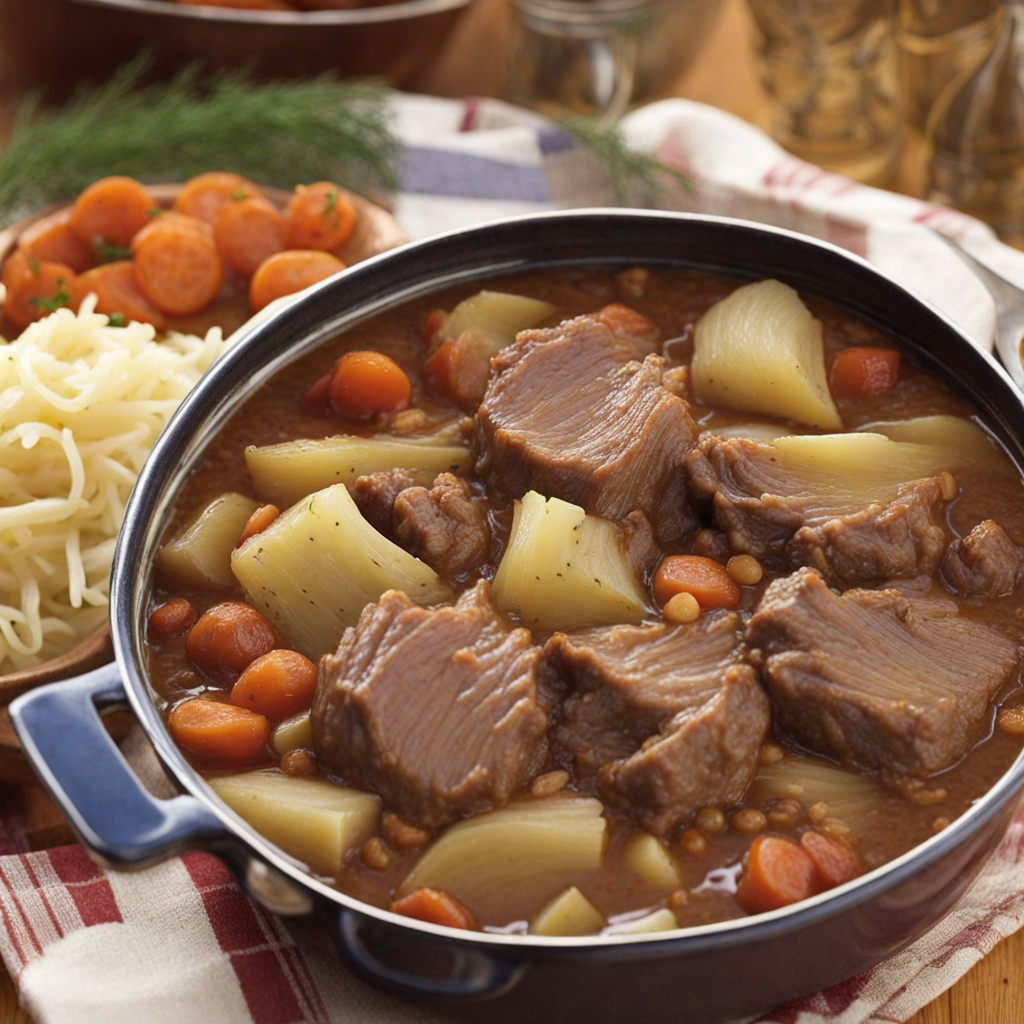Risgrøt
Risgrøt is a traditional Norwegian rice porridge that embodies comfort and nostalgia in every spoonful. Made primarily from short-grain rice, whole milk, and a pinch of salt, this dish is cooked slowly to achieve a creamy, velvety texture. The rice absorbs the milk, breaking down to create a rich, warming porridge that is both satisfying and soothing, perfect for cold winter days. Often enjoyed during the holiday season, Risgrøt is a staple in Norwegian households, evoking memories of family gatherings and festive celebrations. To elevate the flavor, Risgrøt is typically served with a generous sprinkle of cinnamon and sugar, which adds a delightful sweetness and aromatic warmth. A small knob of butter melted on top creates a luscious richness that enhances each bite. Some variations include a hidden almond, a playful tradition where the person who finds it is said to have good luck for the year ahead. This simple yet delightful addition brings an element of surprise and joy to the meal, making it a cherished part of the experience. Risgrøt can be enjoyed at any time of the day, whether as a hearty breakfast or a comforting dessert. Its versatility allows for creative toppings and pairings, such as fresh berries, fruit compotes, or even a drizzle of maple syrup for those seeking a touch of sweetness. With its humble ingredients and heartwarming nature, Risgrøt is not just a dish; it is a warm embrace from Norway's culinary heritage, inviting you to savor the simple pleasures of life.
How It Became This Dish
The History of Risgrøt: Norway’s Creamy Rice Porridge Risgrøt, a traditional Norwegian rice porridge, is more than just a delightful dish; it embodies the rich culinary heritage of Norway and reflects the lifestyle and values of its people. Known for its creamy texture and subtle sweetness, risgrøt has played an important role in Norwegian culture, particularly during festive occasions and family gatherings. This exploration of risgrøt delves into its origins, cultural significance, and evolution over time. #### Origins The roots of risgrøt can be traced back to the introduction of rice to Europe in the Middle Ages. While rice was cultivated in Asia for thousands of years, it only became known to Europeans after the Crusades, around the 13th century. Initial recipes for rice dishes often came from Italy and Spain, where rice was incorporated into both savory and sweet dishes. The transformation of rice into porridge likely arose from the need for a nutritious, easily digestible meal, especially for children and the elderly. In Norway, the cultivation of rice was limited due to the country’s cooler climate and shorter growing seasons. Thus, rice porridge became more of a luxury item, often reserved for special occasions or holidays. The use of milk to create a creamy texture and the addition of sugar or cinnamon for flavoring further solidified risgrøt as a comfort food. #### Cultural Significance Risgrøt holds a special place in Norwegian culture, particularly during the Christmas season. Traditionally, it is served as part of the festive meal on Christmas Eve. The dish is often accompanied by a sprinkle of cinnamon and sugar, and it is customary to place a single almond inside the porridge. The person who finds the almond is said to have good luck in the coming year. This playful tradition adds an element of excitement to the meal and reinforces the sense of community and togetherness during the holidays. In addition to its festive associations, risgrøt has been a staple in Norwegian households throughout the year. It is particularly favored during the cold winter months, serving as a hearty breakfast or a comforting evening snack. The dish is also popular among children, as its creamy texture and sweet flavor appeal to young palates. The preparation of risgrøt has often been a communal activity, with families gathering around the stove to stir the pot and engage in conversation. This practice fosters a sense of bonding and shared experience, emphasizing the dish's role in family life. #### Development Over Time As Norway transitioned through various historical phases, risgrøt evolved to reflect changes in society, ingredients, and culinary techniques. In the early 19th century, as Norway experienced burgeoning agricultural developments, the availability of rice increased, making risgrøt more accessible to the general population. The dish began to appear more frequently in cookbooks and household recipes, solidifying its status as a beloved staple. In the late 19th and early 20th centuries, the rise of industrialization and urbanization influenced Norwegian cuisine. Traditional foods began to adapt to the fast-paced lifestyle of city living. Risgrøt, while still cherished, saw variations with the introduction of new ingredients such as condensed milk and butter, which enhanced its richness. This period also saw the advent of convenience foods, which altered the way risgrøt was prepared and consumed. Pre-packaged rice and instant porridge mixes began to emerge, allowing for quicker preparation times. In recent decades, the resurgence of interest in traditional foods and local ingredients has led to a revival of risgrøt in both home kitchens and restaurants. Chefs have experimented with flavors and presentations, incorporating modern culinary techniques while respecting the dish's heritage. Variations now include the addition of seasonal fruits, nuts, and even spices like cardamom, reflecting a growing trend of culinary fusion and experimentation. #### Contemporary Risgrøt Today, risgrøt is still a beloved dish in Norway, often featured in cafes and restaurants, especially during the winter months. It is served in a variety of forms, from the classic creamy porridge to more contemporary interpretations adorned with fresh berries, compotes, or nut toppings. The dish's versatility allows it to be enjoyed in both casual and fine dining settings. Moreover, risgrøt has found its way beyond Norwegian borders, as diasporic communities share their culinary traditions with the world. Norwegian restaurants abroad often include risgrøt on their menus, introducing a wider audience to this comforting dish. It serves as a culinary bridge, connecting Norwegians in the diaspora to their homeland while inviting others to experience a taste of Norwegian tradition. #### Conclusion Risgrøt represents more than just a simple dish; it is a symbol of Norwegian culture, history, and community. From its origins as a luxury item to its status as a staple comfort food, risgrøt has adapted and evolved while retaining its essential characteristics. Its role in festive celebrations, family gatherings, and daily life underscores the importance of food as a means of connection and identity. As Norway continues to embrace its culinary heritage, risgrøt remains a cherished dish, embodying the warmth and hospitality of Norwegian culture. Whether enjoyed in a cozy home during the winter months or in a trendy restaurant, risgrøt invites all to savor its rich history and comforting flavors. The creamy rice porridge is not just a meal; it is a taste of tradition, a celebration of togetherness, and a reminder of the simple joys that food brings to our lives.
You may like
Discover local flavors from Norway







